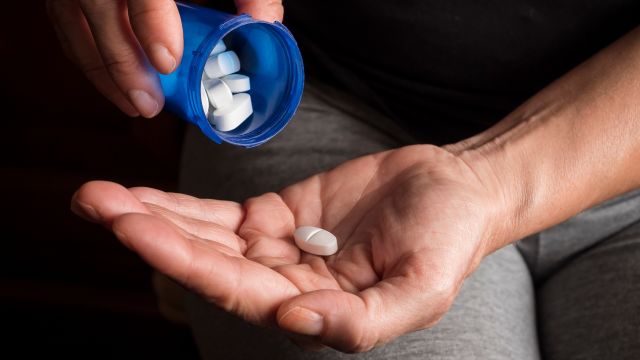Updated on July 25, 2025
Gender-affirming hormone therapy (GAHT) is one of a number of medical interventions that someone who is transgender, gender nonconforming or nonbinary might seek. It involves taking either feminizing or masculinizing hormones, typically forms of estrogen or testosterone.
GAHT (sometimes referred to as hormone replacement therapy, or HRT) can be a helpful option—and even a life-saving treatment—for anyone experiencing gender dysphoria and/or social dysphoria, says Lauren Radziejewski, DNP, ANP-BC, a nurse practitioner based in New York City who specializes in the care of transgender people.
Gender dysphoria refers to the distress and discomfort one might experience when they feel their gender identity doesn’t align with some or all of their physical or physiological characteristics. (Many, but not all, transgender and gender nonconforming people experience gender dysphoria.) Social dysphoria is the feeling some trans people get when others do not treat them as the correct gender.
The distress of gender dysphoria can lead to mental health issues like anxiety, depression, and thoughts of suicide. (If you experience any suicidal thoughts, call, text, or chat 988 to the 988 Suicide & Crisis Lifeline.) The good news is that research shows that gender-affirming care can help alleviate dysphoria.
For many trans and nonbinary people, starting hormone therapy is a relief. Tears of joy are common in the office of Jennifer Aldrich, MD, an professor of clinical medicine at the Lewis Katz School of Medicine at Temple University in Philadelphia, who focuses on transgender and nonbinary health. Providing GAHT is “one of the most rewarding things in medicine,” she says.
What are the goals of taking feminizing hormone therapy?
Feminizing hormone therapy typically involves taking estrogen along with testosterone-blocking medications, such as spironolactone. Estrogen can be taken in several different forms. It’s most commonly delivered in pill form or through a patch you wear on your skin. Less commonly, it’s delivered via injection. A healthcare provider (HCP) will discuss the options and help you determine what form is best for you.
Usually, when someone starts taking estrogen, the general goal is to develop characteristics traditionally associated with the hormone, says Dr. Aldrich. That may include fat redistribution, the growth of breast tissue, and the suppression of characteristics associated with testosterone, like body hair.
Most people also have more specific, personal goals, notes Radziejewski. For example, some people may want some characteristics conventionally associated with femininity, but not others. In other words, hormone therapy doesn’t have to be all or nothing.
Although it’s not possible to pick and choose which characteristics you gain on hormones, Radziejewski notes, GAHT typically starts slowly with patients taking a low dose before it’s increased as needed. In some cases, taking a testosterone blocker alone might be enough to achieve desired results.
What physical, sexual, and reproductive changes can I expect?
People taking feminizing hormones can typically expect to experience the following:
- Breast development: Breast tissue will grow. Some people on feminizing hormone therapy may be comfortable with their final breast size without additional surgery, Aldrich says. But breast augmentation (surgery to increase the size of the breasts) is another gender-affirming treatment option.
- Thinning of body hair: Body and facial hair typically won’t go away with hormone therapy alone but will often soften and get thinner.
- Halting of hair loss: Male-pattern hair loss will typically stop.
- Redistribution of body fat: Preexisting fat will shift slightly, but the change will be gradual, Radziejewski says. Meanwhile, fat will appear in areas typically associated with estrogen, like the butt and hips.
- Reduction of muscle mass: The muscles in your arms and legs will become less defined.
- A change in sweat and odor patterns: You will likely perspire (sweat) less and there might be a change in the smell of your sweat and urine.
- Lessened libido and fewer erections: Patients typically notice a reduction in their libido and tend to have difficulty getting erections. For some, this is a desired change. For those who still wish to have erections, an HCP can prescribe medication.
- Lower sperm count: Although it’s unlikely that someone on feminizing hormone therapy could impregnate a partner, it is possible. So, depending on the patient’s and partners’ plans, anyone having sex that could result in pregnancy should talk with an HCP about contraception.
What may not change?
Your voice will not change on GAHT. Unlike masculinizing hormones, which do tend to change people’s voices, feminizing hormones don’t change the pitch and tone of your voice.
The lower pitch associated with men’s voices is a result of thicker vocal cords. (Picture how the thicker strings on a guitar play lower notes.) Vocal cords thicken in the presence of testosterone, whether that arrives during puberty or hormone therapy. But introducing estrogen to your body won’t thin your vocal cords. If you are interested in changing the sound of your voice, your provider can refer you to a vocal training program.
Taking estrogen and testosterone blockers won’t affect other traits typically associated with testosterone, such as height or the size of your hands and feet.
Will there be emotional changes?
Anyone who has experienced gender dysphoria knows that it can affect your mood. Because GAHT can help alleviate the distress that dysphoria can cause, patients may see improvements in their mood.
“I often see that anxiety is improved when people feel like they’re presenting as their true identity,” Aldrich says.
GAHT can also influence mood in other ways, Aldrich notes. While some people might find an improvement in mood, others might find themselves to be more emotional and experience more mood changes. There isn’t much data to explain why this happens.
Is age a factor?
Once someone has gone through puberty in their sex assigned at birth, those physical changes become harder to reverse or alter with GAHT. So, for those who start feminizing hormone therapy later in life, they are less likely to see significant physical changes from estrogen, although there will be some.
The most significant effects are seen in anyone who has used puberty blockers to stop or halt puberty of their sex assigned at birth and then, through GAHT, to go through puberty in their affirmed gender.
What are the side effects of feminizing hormones?
Like any treatment, feminizing hormones can have side effects.
One of the biggest unknowns is the effect of estrogen on fertility, specifically sperm production and function. That means if you are unsure about your future plans for having children, it’s important to discuss this with your HCP. Some patients decide to bank (or store) sperm prior to starting GAHT. It’s also important to discuss birth control with your HCP if you’re having sex that could result in unintended pregnancy.
What are the risks?
Generally, estrogen is very safe, Radziejewski says, but blood clots (medically known as venous thromboembolism) are a risk in anyone who takes estrogen. These can happen anywhere in the body but pose the greatest risk when they occur in your lungs or brain. Even when clots form elsewhere in the body, there is a risk that they can travel to your lungs. If you ever have chest pain, shortness of breath, or difficulty breathing, let your HCP know right away and mention that you are taking estrogen.
The overall risk of developing a blood clot is relatively small. One study found that one percent of transgender women on estrogen had blood clots. But people who are older, have a family history of blood clots, and those who smoke should be particularly mindful of the risk.
“When people smoke, I want them to stop,” Radziejewski says. She might still prescribe hormone therapy even if a patient didn’t quit smoking, but would likely recommend they use a patch instead of a pill. (Research has shown that the patch comes with a lower risk of blood clots.) Your HCP will also monitor your potassium levels and kidney function if you take testosterone blockers.
How can I access feminizing hormone therapy?
If you’re interested in starting feminizing hormone therapy, start with a trusted HCP. If you don’t see a provider regularly, Radziejewski recommends checking out your local LGBTQIA+ center, if there’s one in your area, or searching for providers through organizations such as TransPulse and OutCare. Planned Parenthood also offers GAHT.
It can be risky to obtain hormones outside of conventional channels, so make sure that you are working with a licensed, experienced HCP to get the affirming, culturally competent care you need.






